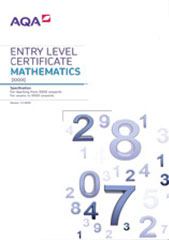3.1 Component 1: properties of number
This content aims to develop the student’s understanding and use of number.
Students will learn about place value within whole numbers and will undertake calculations using mental arithmetic and using a calculator. Students will understand the terms odd and even, and rounding will be introduced.
Procedures for making and recording assessments
Class work assessed by the teacher in response to the outcomes set out below, or assessed by an externally set assignment.
Outcomes to be accredited
In successfully completing this component, students will have demonstrated the ability to:
Entry 1
|
Outcomes |
Notes/examples |
GCSE reference |
|---|---|---|
| 1.1 Count reliably up to 20 items | ||
| 1.2 Read, write, order and compare numbers up to 20, including zero |
Say which of two numbers is smaller or larger Say which of three or more numbers is the smallest or the largest Put three or more numbers in order, starting with the smallest |
N1 |
| 1.3 Complete a number line up to 20 |
Fill in the blanks on a number line counting up or down |
Entry 2
|
Outcomes |
Notes/examples |
GCSE reference |
|---|---|---|
|
2.1 Read, write, order and compare numbers up to 100 |
Numbers could be in context. Key words are smaller, larger, less, more, fewer, smallest, largest, least, most, fewest |
N1 |
|
2.2 Recognise place value in two digit numbers |
N2 |
|
|
2.3 Count from 0 in steps of two, three and five |
Fill in blanks in the list of multiples of 2 up to 24 (36 for 3 and 60 for 5) The list could be counting up or down |
N4 |
|
2.4 Round numbers less than 100 to the nearest 10 |
N15 |
|
|
2.5 Understand and identify odd and even numbers |
Write down an even number between 7 and 13 |
Entry 3
|
Outcomes |
Notes/examples |
GCSE reference |
|---|---|---|
| 3.1 Read and write numbers up to 1,000 | ||
| 3.2 Order and compare numbers up to 1,000 |
N1 |
|
| 3.3 Recognise place value in three digit numbers |
In 482, which is the units digit? |
N2 |
| 3.4 Round numbers less than 1,000 to the nearest 10 |
N15 |
|
| 3.5 Round numbers less than 1,000 to the nearest 100 |
N15 |
|
| 3.6 Find 10 or 100 more or less than a given number | ||
| 3.7 Recognise and use multiples of 2, 3, 4, 5, 8, 10, 50 and 100 |
Key word: multiple |
N4 |
